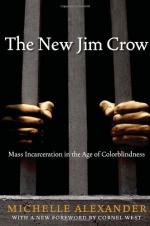
|
| Name: _________________________ | Period: ___________________ |
This test consists of 5 multiple choice questions, 5 short answer questions, and 10 short essay questions.
Multiple Choice Questions
1. In what case did the Ninth Circuit Court of Appeals strike down the "no fault" clause on the ground that eviction of innocent tenants was inconsistent with the legislative scheme?
(a) Brown v. Board of Education.
(b) McClesky v. Kemp.
(c) Plessy v. Ferguson.
(d) Rucker v. Davis.
2. The increase in the number of African American males sent to prison for drug crimes increased by what percentage between 1985 and 2005?
(a) 1,000%.
(b) 300%.
(c) 500%.
(d) 2,000%.
3. In 2006, one in how many African American men was behind bars?
(a) 106.
(b) 14.
(c) 20.
(d) 29.
4. One in how many black men between the ages of 20-35 was behind bars in 2006?
(a) 42.
(b) Nine.
(c) 29.
(d) 16.
5. What were the defendants in Yick Wo v. Hopkins accused of doing?
(a) Operating laundries without licenses.
(b) Operating restaurants without licenses.
(c) Murder and kidnapping.
(d) Forgery and extortion.
Short Answer Questions
1. Where was Edward Clary stopped and searched when he was 18?
2. When did the article "Where Have the Black Men Gone" appear in Ebony magazine?
3. The author asserts in Chapter 3: "The Color of Justice" that in the federal system, homicide offenders account for 0.4% of the past decade's growth in the federal prison population while drug offenders account for what percent of that expansion?
4. What are the only two states that allow inmates to vote while incarcerated?
5. Who was the former director of the White House Office of National Drug Control Policy that stated that if your child bought drugs, "it was from a student of their own race generally"?
Short Essay Questions
1. What does the author mean when she refers to "second-class citizens" in the book?
2. When did Whren v. United States go before the Supreme Court? What was the Court's decision?
3. How does political disenfranchisement apply to Jim Crow and mass incarceration, according to the author in Chapter 5: "The New Jim Crow"?
4. How does the author compare the incarceration rates of blacks and whites in the U.S. for drug offenses versus the statistics of use among blacks and whites in the country?
5. What was enacted with the Anti-Drug Abuse Act of 1988?
6. How does racial segregation apply to Jim Crow and mass incarceration, according to the author in Chapter 5: "The New Jim Crow"?
7. How does the author compare the circumstances of a freed prisoner to those of a black person living in Mississippi at the height of Jim Crow in Chapter 4: "The Cruel Hand"?
8. How does the author describe the circumstances of Emma Faye Stewart's arrest in Chapter 3: "The Color of Justice"?
9. What is noted about Frederick Douglass's speech at the National Colored Convention in 1853 in Chapter 4: "The Cruel Hand"?
10. What circumstances led to Clinton Drake's inability to vote?
|
This section contains 873 words (approx. 3 pages at 300 words per page) |

|




